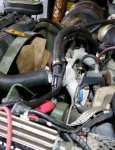- 5,872
- 8,184
- 113
- Location
- Papalote, TX
The 200A install is pretty straight forward, but I thought I would hit the highlights using a NOS 200A install kit and a used 200A alternator, I did not take any photos during the actual mounting of the alternator will try to remember the wrench size for each bolt, there is an eclectic collection of SAE and metric bolts, I probably will miss a couple steps so common sense should prevail, and the install sheet is available here somewhere.
1 disconnect neg battery cable.
2 Crawl under the truck and remove the lower PS pump adjustment bolt (3/4)
3 remove all the belts.
4 Disconnect all the wires from the existing alternator, remove the slotted adjustment arm (2X9/16) and the alternator (2X15mm)
5 remove the upper PS pump adjustment bolt (9/16) and the pivot bolt (15mm) the pump will fall away so be careful, let it lay forward so you can have access to the alternator mounting bracket.
6 remove the existing alternator bracket (2X15mm), remove old rear alternator support bracket (15mm), old wire support bracket and replace the stud in the exhaust manifold with one provided in the kit, install new wire support bracket and new rear alternator support bracket, do not tighten the nut on the alternator support bracket (note the old/new studs look the same, maybe a higher grade?)
7 install new alternator bracket with original bolts, (install the PS pivot bolt through the new bracket finger tight before tightening the two other bracket bolts so that hole will be aligned for the next step), mount PS pump with original bolts.
8 An engine crane or something similar would be helpful at this point, I set the alternator by myself without any mechanical aid so it can be done, but I also had the hood and tires off and the truck was on my lift so I could lower it to a very low level, (actually looks pretty ominous sitting that low, put some tiny wheels on it and it would make an awesome clown car!!)
I found it was easiest to start a 3/8 3 inch or so bolt in the front first, then start the rear bolt through the support bracket, then the rear alternator mounting ear, then after getting it going through the alternator bracket gently tapping it with a plastic hammer to drive out the 3/8 bolt in the front while supporting best I could the front of the alternator.
9 put the washers and nut on the front of the alternator pivot bolt and install the new adjustment bracket, install belts starting with the single (now) PS belt, tighten PS belt first then the alternator belts.
Now on to the wiring, with pics!
1 disconnect neg battery cable.
2 Crawl under the truck and remove the lower PS pump adjustment bolt (3/4)
3 remove all the belts.
4 Disconnect all the wires from the existing alternator, remove the slotted adjustment arm (2X9/16) and the alternator (2X15mm)
5 remove the upper PS pump adjustment bolt (9/16) and the pivot bolt (15mm) the pump will fall away so be careful, let it lay forward so you can have access to the alternator mounting bracket.
6 remove the existing alternator bracket (2X15mm), remove old rear alternator support bracket (15mm), old wire support bracket and replace the stud in the exhaust manifold with one provided in the kit, install new wire support bracket and new rear alternator support bracket, do not tighten the nut on the alternator support bracket (note the old/new studs look the same, maybe a higher grade?)
7 install new alternator bracket with original bolts, (install the PS pivot bolt through the new bracket finger tight before tightening the two other bracket bolts so that hole will be aligned for the next step), mount PS pump with original bolts.
8 An engine crane or something similar would be helpful at this point, I set the alternator by myself without any mechanical aid so it can be done, but I also had the hood and tires off and the truck was on my lift so I could lower it to a very low level, (actually looks pretty ominous sitting that low, put some tiny wheels on it and it would make an awesome clown car!!)
I found it was easiest to start a 3/8 3 inch or so bolt in the front first, then start the rear bolt through the support bracket, then the rear alternator mounting ear, then after getting it going through the alternator bracket gently tapping it with a plastic hammer to drive out the 3/8 bolt in the front while supporting best I could the front of the alternator.
9 put the washers and nut on the front of the alternator pivot bolt and install the new adjustment bracket, install belts starting with the single (now) PS belt, tighten PS belt first then the alternator belts.
Now on to the wiring, with pics!
Last edited:










